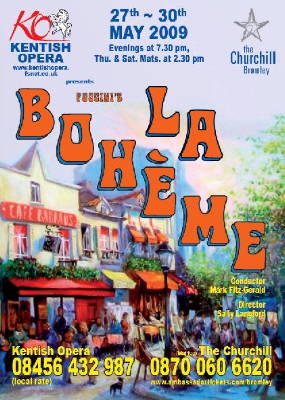|

Student Life and Love
Puccini's 'La bohème' from Kentish Opera,
enjoyed by PIPPA HARE
The French word bohémien was used in France as far back as the sixteenth century when referring to gypsies. Later it came to be connected with the counter-culture of young artists in the Latin Quarter of nineteenth century Paris.
Giacomo Puccini's opera, with a libretto based on the novel Scènes de la vie de bohème by Henry Murger, was first performed at the Teatro Regio, Turin in 1896 under the baton of the young Toscanini.
La bohème, one of the most popular and best-loved operas ever, combines characterization, sentiment and craftsmanship, and has the perfect blend of joy and pathos. At the beginning we have all the excitement and ebullience of youth, enjoying student life and love, and by the end of the opera, its characters have experienced a taste of death at first hand.
Essaying such a well-known opera can leave artists wide open to criticism, but Kentish Opera's performance on 27 May 2009 [Churchill Theatre, Bromley, Kent, UK] cannot have disappointed many in the audience. Artistic director Sally Langford should be delighted with her latest production.

In a most convincingly constructed tiny attic room there is much camaraderie between Marcello and Rodolfo. Despite hunger, cold and lack of money, cheerfulness prevails. In their duet 'Questo mar rosso' they cheerily agree to burn their own work. David Newman did well stepping into Philip O'Brien's place as Rodolfo, and his rapport with Mimi (Ruth Kerr) came out in their love duet 'O soave fanciulla' ('Lovely maid in the moonlight'), beautifully sung by the new lovers. This theme recurs several times during the opera.
Although Colline (Andrew Kidd) and Schaunard (Mark Saberton) have smaller parts, their voices were well-chosen and their cavorting was splendid.
The harp played a big part in this production, and Janice Bevan brought out a beautiful sound. I felt that Mark Fitz-Gerald's orchestra needed to play just a little softer.
Carol Stevenson's costumes introduced a wonderful array of colour as Act II opened to reveal the Café Momus in the Latin Quarter of Paris on Christmas Eve. In amongst the 'sea' of people and children there are snatches of chorus and recitative which run through the scene and enhance the general merriment. The chorus did well and the children were a joy, clearly well-rehearsed, seemingly in control of their roles and enjoying the privilege of being part of it all.
Musetta (Marcello's ex girlfriend, sung by Rebecca Hodgetts) was excellently cast as a fickle and flirtatious young woman, out for all she could get. Her waltz song 'Quando m'en vo' ('As through the streets I wander') not only brought out her lovely soprano voice but also brought back her lover Marcello! We hear more of Marcello's mellow baritone voice, provided by Peter Grevatt, in Act III.
Act IV's dénouement starts as the four young men frolic around the attic. Rodolfo, still feeling let down by Mimi, sings 'Ah Mimi, tu piu non torni' ('Ah Mimi, fickle-hearted'), but almost at once the atmosphere changes when Musetta brings in Mimi, now clearly dying of consumption. The phrases 'Che gelida manina' and 'Mi chiamano Mimi' from their first love song return as laments, and Mimi slips away, gracefully and silently, leaving the distraught Rodolfo desperately crying out her name.
Copyright © 11 June 2009
Pippa Hare,
Kent UK

GIACOMO PUCCINI LA BOHEME LOVE DEATH CHRISTMAS EVE PARIS FRANCE ITALY UNITED KINGDOM
| 
